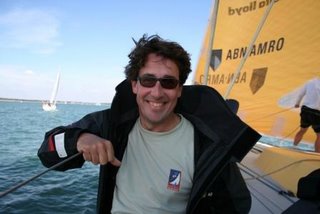Big Four flop in the fleet racing
Alinghi might be leading the fleet racing of the Louis Vuitton Act 11 of the
+39 Challenge, on the other hand, did exactly what they needed to in a slow boat, and booked the pin end of the line where Iain Percy could accelerate and put the bow down. Rounding the first mark in third place was a sensational result for the Italian team in the oldest boat on the race course.
Another Italian team, Luna Rossa, led for the first half of the beat but ITA-86 seemed to fall out of phase with the shifts – if indeed there was a phase to the shifts. Francesco Bruni, who works the traveller on the boat, later explained that because of the sloppy waves the team decided not to send a man up the rig. The waves were out of all proportion to the six-knot breeze, and it was hard to keep boats moving. Bruni said: “To reduce the pitching of the boat we decided not to send anyone up the mast. We missed a big shift to the right and arrived at the top mark with a bunch of boats. We tried a risky tack and we thought we were alright, but the umpires judged that we tacked too close and gave us a penalty.”
So having rounded the mark in 8th, after the penalty the Italians dropped to 10th and they never recovered from there. BMW Oracle rounded in 4th but could make nothing of it, dropping to 9th by the finish. Alinghi climbed from 9th to a not particularly inspiring 6th at the end. Of the big teams, only the Kiwis made anything of that first race, although even they were pipped at the post for 3rd place by +39, of all teams.
So who did do well? Victory Challenge, who led around the first mark after hooking into a good right-hand shift. Perhaps it was the inspiration of multiple Olympic medallist, Lord Sebastian Coe, who was riding as 18th man on the Swedish boat. Whatever it was, Magnus Holmberg’s team were on fire, winning by over a minute and a half from another surprise package, Mascalzone Latino.
The second race ran a little more to form but not by much. This time it was Alinghi’s turn to dominate, BMW Oracle again nowhere to be seen. It was the first time the Americans were racing with their jumperless rig, and people were wondering if that was the problem. But it really wasn’t a day for assessing speed. Today was about plain good sailing, and what today revealed is that every team has talented seat-of-the-pants sailors in their midsts. Light and fluky is not the most thrilling spectacle, but it certainly shakes up the pack nicely.
